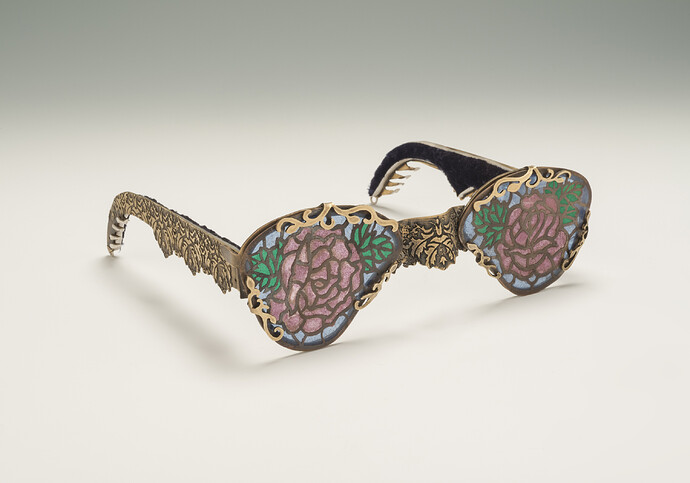Materials: Fine silver, sterling silver, brass, copper, enamel, velvet
Dimensions: 6" x 6" x 2 1/2"
Plique-a-jour, pierced, etched, forged, fabricated, cold connections, handmade hinges, velvet lined
This piece is descriptive of the “rose colored lenses” through which we all see the people we love. They hide every flaw, and show us only what we want to see. The padded velvet lining makes them extremely comfortable to wear, but heaven forbid you should ever have to take them off. The sharp barbs on the back of the earpiece will inflict pain and even injury on the wearer should they attempt to remove them. This is representative of the severe emotional distress associated with the realization that the person we loved is not who we thought they were.
Photo credit: Emily Fruth
Emily Jean Fruth
Napoleon, Ohio. USA
The majority of my work revolves around memories and personal relationships. The people who have been influential in my life, a particular dynamic of a past relationship, an image that somewhere along the line became iconically connected to a precious memory: these, for example, form the preponderance of my influences. In addition to this, my visual aesthetic tends to combine the architectural with the diaphanous. I like my work have physical presence, while I also like to use surface embellishments like piercing and enameling to imply intricacy and delicacy.
To me, my work represents empowerment. The world around me goes through its cycles so quickly that, at times, I find it difficult to keep up. The best way that I have found to interact with a moment, feeling, or thought that seems too overwhelming to be dealt with at the time is to capture it, in a solid and tangible form, to be presented to a viewer. In this way, not only am I able to share my ideas with others in a cohesive manner, but I also have a proactive process with which to turn my own thoughts into something that I can see, touch, and interpret. Metalsmithing provides me with a way to actively influence my environment, clarify my thoughts, and hopefully contribute something meaningful to the world along the way.
The exhibition explores metal works whose primary theme is color embraced as their primary visual focus, whether that be using colored materials, exploring creating colored surfaces, or encasing the object in color.
As the world's largest jewelry related internet site, Ganoksin strives to develop exhibitions showcasing work from around the world. This exhibition was open to all metalsmiths, professional and amateur, advanced and beginner.
In total 303 artists contributed 814 show pieces for the permanent online exhibition.
The exhibition was curated by Beth Wicker, President of the North Carolina Society of Goldsmiths in the United States, and Adjunct Instructor at Northeastern Technical College in South Carolina. Director of the exhibition is Hanuman Aspler, founder of The Ganoksin Project, the world's largest internet jewelry site.
Hue is one of the primary properties of color, it refers to the place the color occupies on the visual spectrum. Humans have used hues throughout time, to create cave paintings, to decorate themselves, their clothing and their housing.
Different hues have taken on different meanings throughout time. Gold traditionally has been a color of purity - the metal gold is relatively unchangeable, and the hue of gold has come to stand for gods and goddesses, for royalty, for durability and for purity. Red has often meant love, or passion. Hues often reflect the meaning of the seasons, with pastels referring to spring and the burst of new life after the pale hues of winter. Summer is reflected in vibrant, deep hues, followed by the browning of hues in the fall as plants go to seed and die, and the land turns fallow.
The worth of a hue has often been tied to what is necessary to make the pigment that creates the hue, and the expensive involved in the process. Often created from crushed stones that had to be mined and carried by caravan over thousands of miles, or from fermented roots of plants only grown in certain areas, or the carapaces of rare insects - the creation of hue in a way that could be used by man was an involved and generally expensive process.
In today's world metalsmiths have access to perhaps the widest range of materials and hues in the history of man - and in some of the most affordable ways ever.
This exhibition celebrates hue - color - as an integral, inherent element of the work. We talk of the "richness" of color, and examples of this abound here. One expects hues from the colors of gemstones used in metalsmithing, but we also have hues from some less expected places. Glass enamels are an ancient way of adding color, as are a variety of patinas. Today's artists also use synthetic man-made materials to add color in ways that didn't exist a century ago.
We invite you to enjoy this celebration of hue, and the ways hues and their use have changed over time.
